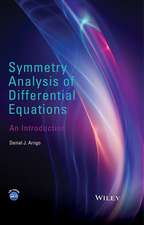Nonlinear Symmetries and Nonlinear Equations: Mathematics and Its Applications, cartea 299
Autor G. Gaetaen Limba Engleză Paperback – 14 oct 2012
Din seria Mathematics and Its Applications
- 9%
 Preț: 627.25 lei
Preț: 627.25 lei - 18%
 Preț: 945.62 lei
Preț: 945.62 lei - 15%
 Preț: 648.42 lei
Preț: 648.42 lei - 15%
 Preț: 651.99 lei
Preț: 651.99 lei - 15%
 Preț: 591.61 lei
Preț: 591.61 lei -
 Preț: 394.29 lei
Preț: 394.29 lei - 18%
 Preț: 950.17 lei
Preț: 950.17 lei - 15%
 Preț: 586.85 lei
Preț: 586.85 lei - 5%
 Preț: 655.17 lei
Preț: 655.17 lei - 15%
 Preț: 658.70 lei
Preț: 658.70 lei - 15%
 Preț: 648.56 lei
Preț: 648.56 lei - 15%
 Preț: 604.84 lei
Preț: 604.84 lei -
 Preț: 394.87 lei
Preț: 394.87 lei - 15%
 Preț: 651.84 lei
Preț: 651.84 lei -
 Preț: 374.76 lei
Preț: 374.76 lei -
 Preț: 394.51 lei
Preț: 394.51 lei - 15%
 Preț: 706.30 lei
Preț: 706.30 lei -
 Preț: 391.02 lei
Preț: 391.02 lei -
 Preț: 389.70 lei
Preț: 389.70 lei - 15%
 Preț: 585.04 lei
Preț: 585.04 lei - 15%
 Preț: 653.98 lei
Preț: 653.98 lei - 15%
 Preț: 587.02 lei
Preț: 587.02 lei - 20%
 Preț: 577.43 lei
Preț: 577.43 lei -
 Preț: 395.47 lei
Preț: 395.47 lei - 15%
 Preț: 601.88 lei
Preț: 601.88 lei - 15%
 Preț: 594.53 lei
Preț: 594.53 lei - 15%
 Preț: 651.84 lei
Preț: 651.84 lei - 15%
 Preț: 649.06 lei
Preț: 649.06 lei -
 Preț: 392.21 lei
Preț: 392.21 lei - 15%
 Preț: 649.06 lei
Preț: 649.06 lei - 15%
 Preț: 643.48 lei
Preț: 643.48 lei -
 Preț: 389.49 lei
Preț: 389.49 lei
Preț: 387.58 lei
Nou
Puncte Express: 581
Preț estimativ în valută:
74.17€ • 77.15$ • 61.23£
74.17€ • 77.15$ • 61.23£
Carte tipărită la comandă
Livrare economică 14-28 aprilie
Preluare comenzi: 021 569.72.76
Specificații
ISBN-13: 9789401044431
ISBN-10: 9401044430
Pagini: 284
Ilustrații: XIX, 258 p.
Dimensiuni: 160 x 240 x 15 mm
Greutate: 0.4 kg
Ediția:Softcover reprint of the original 1st ed. 1994
Editura: SPRINGER NETHERLANDS
Colecția Springer
Seria Mathematics and Its Applications
Locul publicării:Dordrecht, Netherlands
ISBN-10: 9401044430
Pagini: 284
Ilustrații: XIX, 258 p.
Dimensiuni: 160 x 240 x 15 mm
Greutate: 0.4 kg
Ediția:Softcover reprint of the original 1st ed. 1994
Editura: SPRINGER NETHERLANDS
Colecția Springer
Seria Mathematics and Its Applications
Locul publicării:Dordrecht, Netherlands
Public țintă
ResearchCuprins
I - Geometric setting.- a): Equations and functions as geometrical objects.- b): Symmetry.- References.- II - Symmetries and their use.- 1. Symmetry of a given equation.- 2. Linear and C-linearizable equations.- 3. Equations with a given symmetry.- 4. Canonical coordinates.- 5. Symmetry and reduction of algebraic equations.- 6. Symmetry and reduction of ODEs.- 7. Symmetry and symmetric solutions of PDEs.- 8. Conditional symmetries.- 9. Conditional symmetries and boundary conditions.- References.- III - Examples.- 1. Symmetry of algebraic equations.- 2. Symmetry of ODEs (one-soliton KdV).- 3. Symmetry of evolution PDEs (the heat equation).- 4. Table of prolongations for ODEs.- 5. Table of prolongations for PDEs.- IV - Evolution equations.- a): Evolution equations - general features.- b): Dynamical systems (ODEs).- c): Periodic solutions.- d): Evolution PDEs.- References.- V - Variational problems.- 1. Variational symmetries and variational problems.- 2. Variational symmetries and conservation laws: Lagrangian mechanics and Noether theorem.- 3. Conserved quantities for higher order variational problems: the general Noether theorem.- 4. Noether theorem and divergence symmetries.- 5. Variational symmetries and reduction of order.- 6. Variational symmetries, conservation laws, and the Noether theorem for infinite dimensional variational problems.- References.- VI - Bifurcation problems.- 1. Bifurcation problems: general setting.- 2. Bifurcation theory and linear symmetry.- 3. Lie-point symmetries and bifurcation.- 4. Symmetries of systems of ODEs depending on a parameter.- 5. Bifurcation points and symmetry algebra.- 6. Extensions.- References.- VII - Gauge theories.- 1. Symmetry breaking in potential problems and gauge theories.- 2. Strata in RN.- 3. Michel’s theorem.- 4.Zero-th order gauge functionals.- 5. Discussion.- 6. First order gauge functionals.- 7. Geometry and stratification of ?.- 8. Stratification of gauge orbit space.- 9. Maximal strata in gauge orbit space.- 10. The equivariant branching lemma.- 11. A reduction lemma for gauge invariant potentials.- 12. Some examples of reduction.- 13. Base space symmetries.- 14. A scenario for pattern formation.- 15. A scenario for phase coexistence.- References.- VIII - Reduction and equivariant branching lemma.- 1. General setting (ODEs).- 2. The reduction lemma.- 3. The equivariant branching lemma.- 4. General setting (PDEs).- 5. Gauge symmetries and Lie point vector fields.- 6. Reduction lemma for gauge theories.- 7. Symmetric critical sections of gauge functionals.- 8. Equivariant branching lemma for gauge functionals.- 9. Evolution PDEs.- 10. Symmetries of evolution PDEs.- 11. Reduction lemma for evolution PDEs.- References.- IX - Further developements.- 1. Missing sections.- 2. Non Linear Superposition Principles.- 3. Symmetry and integrability - second order ODEs.- 4. Infinite dimensional (and Kac-Moody) Lie-point symmetry algebras.- 5. Symmetry classification of ODEs.- 6. The Lie determinant.- 7. Systems of linear second order ODEs.- 8. Cohomology and symmetry of differential equations.- 9. Contact symmetries of evolution equations.- 10. Conditional symmetries, and Boussinesq equation.- 11. Lie point symmetries and maps.- References.- X - Equations of Physics.- 1. Fokker-Planck type equations.- 2. Schroedinger equation for atoms and molecules.- 3. Einstein (vacuum) field equations.- 4. Landau-Ginzburg equation.- 5. The ?6 field theory (three dimensional Landau-Ginzburg equation).- 6. An equation arising in plasma physics.- 7. Navier-Stokes equations.- 8. Yang-Mills equations.-9. Lattice equations and the Toda lattice.- References.- References and bibliography.
















